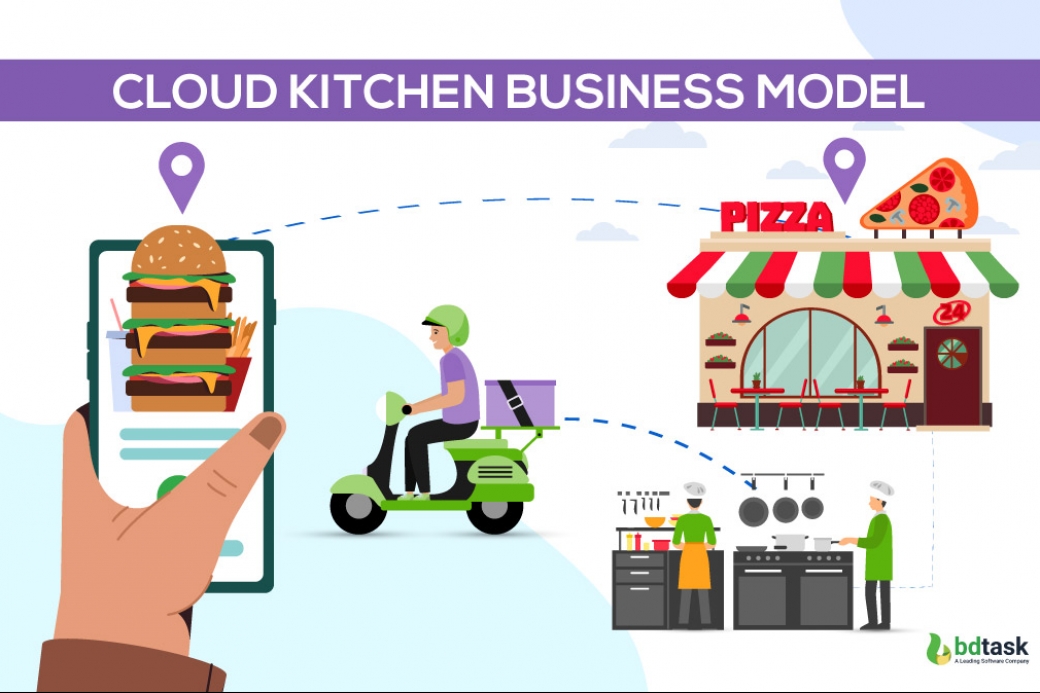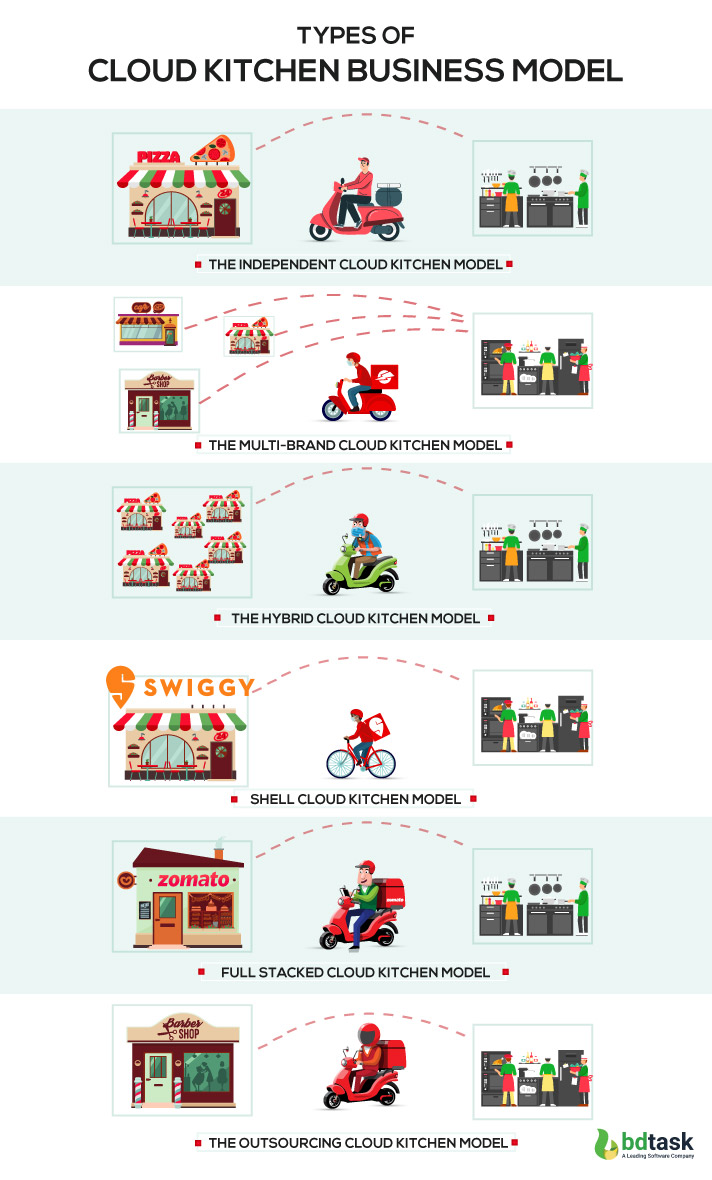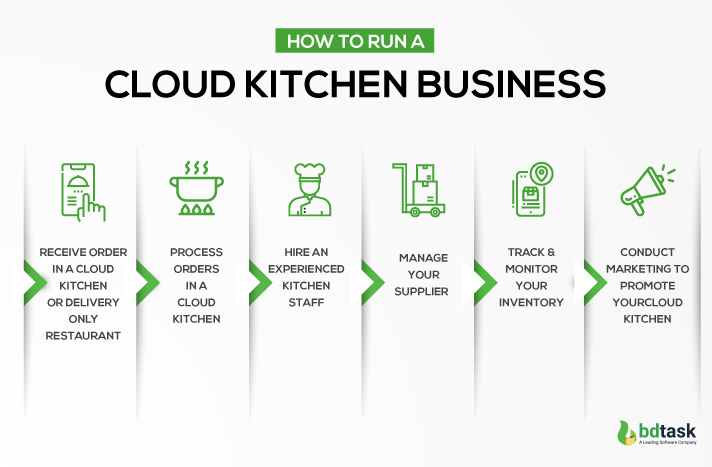Cloud Kitchen Business Model: Everything You Need to Know!

Want to start a cloud kitchen business? Looking for the cloud kitchen business model? Though there are various types of cloud kitchen business model that exists. But you need to start your cloud kitchen business according to your preferred type.
The growth of the online food ordering sector has created new business options for both established and new restaurants, one of which is the Cloud Kitchen business model. The Cloud Kitchen concept is a new food business ideology that has lately taken hold. According to a statistic,
“The growth rate of cloud kitchen business is around 13.5% and most restaurant owners would want to open a cloud kitchen business”. Source
In this article, you will be informed about the basic concept of the cloud kitchen business and 6 types of cloud kitchen business models as well as 6 steps to run your business successfully. It will assist you to choose your desired one and you can easily start your cloud kitchen business.
What Is a Cloud Kitchen Business Model?
A cloud kitchen refers to a centralized commercial cooking environment that gives food businesses the tools and resources they need to make menu items for delivery and takeaway. The cloud kitchen business model allows delivery-only restaurant that does not have a physical location where customers can dine.
Moreover, there is no required fancy infrastructure, furniture, table, and waiters. The cloud kitchen business model can allow the customers to place their orders online through online food aggregator apps or restaurant websites. It is also known as a ghost kitchen or virtual kitchen.
6 Types of Cloud Kitchen Business Model

There are various types of cloud kitchen business model that exists in the present market. Without knowing the types clearly, you can not start your cloud kitchen business.
Moreover, you can understand how to make the most of these six alternative cloud kitchen business models so you can decide which one is right for your business. So, let’s see.
The Independent Cloud Kitchen Model
The independent cloud kitchen allows single brand, single kitchen, and no storefront in this model. This cloud kitchen business model allows you to receive orders from multiple third-party apps like UberEats, DoorDash, and Grubhub. Thus, this is the basement of the cloud kitchen business model.
In this process, you simply prepare your delicious food or beverage item, wrap it for travel, and place it at the front for the delivery driver to pick up and bring to your customer once you receive the order via the app.
Moreover, there is no required seating space and the physical store. Also, you can easily avoid the high rental and real estate costs by shedding the front of the house. With the rise of online ordering and customer demand for deliveries, this independent cloud kitchen model gained popularity.
Most significantly, this model is easy to operate and quick to serve. Also, it does not require any additional cost and for that reason, it is being more popular day by day.
Kitchen Size
You need around 500 – 600 sq ft.
Working Process
- Receive orders come from online sources
- Prepare food in the kitchen
- Specialized in a cuisine
- Deliver food items
- Allows self-delivery or via aggregator for orders and deliveries.
The Multi-Brand Cloud Kitchen Model
The multi-brand cloud kitchen allows multiple brands, a single kitchen, multiple outlets, and no storefront in this model. The working mechanism is the same as in the independent model.
It allows to get the order through an app, prepare it, and have the driver deliver it to the consumer. The main difference is that you need to manage several brands from the same kitchen in this process.
The most advanced cloud kitchens are based on local citizens' information intelligence, popular food, and hyper-commercial demand. This process is quite similar to the original cloud kitchen model and you do not require any physical storefront. You might think of it as specialty cuisine cloud restaurants that are all owned by the same parent company and share the same kitchen.
The goal is to meet the demand for the greatest cuisine in a location (5-6 kilometers from the city) with fewer possibilities for serving it (Biriyani, Chinese, Burgers, North Indian, Pizza, and Pasta).
Most significantly, it is a clever cloud kitchen business model because you just need a single kitchen and you can serve multiple brands as well as outlets. you need to bear the low operational cost.
Kitchen Size
You can build it according to your flexible size.
Working Process
- Receive orders from multiple online sources.
- Prepare food items in a single kitchen.
- Conduct multiple brands and outlets.
- Each brand is focused on a specific cuisine.
- Deliver food items.
- Allows self-delivery or via aggregator for orders and deliveries.
The Hybrid Cloud Kitchen Model
The hybrid cloud kitchen allows a single kitchen, single brand, multiple outlets with a storefront in this model. This process is a mix of a dining room and a cloud kitchen. It is similar to a cloud kitchen business model, but it also has a physical storefront.
The storefront's attractiveness is that consumers may come in and watch their food being prepared if they like. This approach effectively incorporates the cloud kitchen's business strategy's operational efficiencies, but it also contains a "real" consumer window.
Kitchen Size
You need around 1200 – 2000 sq ft.
Working Process
- Receive orders from online sources
- Prepare food items in a single kitchen
- Connect single brand and multiple outlets
- Offers a diversified menu that has a mix of seasonal dishes and bestsellers
- Allows delivery and take away
- Self-delivery or via aggregator for orders and deliveries.
Shell Cloud Kitchen Model
The shell cloud kitchen model allows aggregator owned, multiple brands, rented co-working kitchens, and no storefront in this model. This model allows you to receive orders from third-party delivery apps.
This cloud-based kitchen model is essentially a well-located, unoccupied cooking area with the bare minimum infrastructure of gas pipelines, drainage systems, and ventilation systems in the foodservice industry.
To set up a restaurant, established (or new) restaurant operators rent that kitchen space and employ Swiggy's online ordering, delivery fleet, and menu intelligence. In this regard, Swiggy will compel you to sign an exclusive contract with them, after which you will be required to make the item and have it delivered.
Moreover, the restaurant provides all of the necessary equipment, personnel, raw supplies, and recipes. Simply put, the restaurant prepares the food and Swiggy handles the rest.
Kitchen Size
You need to require 100-500 sq ft
Working Process
- Receive orders from Swiggy
- Prepare food items in a single kitchen
- Connect with multiple restaurant partners
- The restaurant supervises the menu, kitchen equipment, and others
- Delivery via aggregator
Full Stacked Cloud Kitchen Model
The full stacked cloud kitchen allows aggregator-owned, rented kitchens, and multiple restaurant brands with a storefront in this model. This model works based on the concept of a rented kitchen which is integrated with kitchen equipment and comprehensive processes.
Zomato is used this cloud kitchen business model like Swiggy, but this model is quite different from than Swiggy access cloud kitchen model. This model can be able to manage orders according to the demand of customers.
These cloud kitchens, like the Freshmenu model, feature a storefront where consumers may stroll in. Similar to the Freshmenu example, a mash-up between a cloud kitchen and a takeaway restaurant. Zomato's insights have been used to power this model.
Kitchen Size
You need to require around 250-500 sq ft.
Working Process
- Receive orders from Zomato
- Prepare food items in a single kitchen
- Connect with multiple restaurant partner brands
- The restaurant supervises the menu and food items
- Allows take away
- Delivery via aggregator
The Outsourcing Cloud Kitchen Model
The outsourcing cloud kitchen model allows cooking and delivering fully outsourced. This concept is newer in the cloud kitchen business. In this cloud kitchen business model, you need to outsource everything from your call center operations to your kitchen, and delivery.
Moreover, this cloud kitchen business framework is used in the Kitopi business model. In this model, you can consider a restaurant where a significant portion of the kitchen prep is outsourced and delivered to your location. After that, your chefs can put the finishing touches on it before Kitopi picks it up for delivery.
Kitchen Size
You can build it according to your flexible size.
Working Process
- Receive orders via Kitopi owned call center, own online platform, and third-parties
- Allows to buy and store raw materials
- Prepare food items in a centralized kitchen
- Send food items to your kitchen for the final touch
- Pickup Deliver food items
How to Run a Cloud Kitchen Business?

The restaurant may launch many brands utilizing the same cooking infrastructure thanks to the cloud kitchen architecture. Multi-brand cloud kitchens allow a restaurant to operate many brands using the same infrastructure and resources.
From the previous discussion, you can choose your preferred cloud kitchen business model. Here, you will get 6 effective steps to run a cloud kitchen business successfully. So, let’s start.
Step 1: Receive Order in a Cloud Kitchen or Delivery Only Restaurant
A cloud kitchen POS is necessary for Cloud Kitchens because the major source of order-taking is online. Orders can be placed through a variety of channels, including online food aggregators, ordering-enabled websites, and the telephone.
Since each online food aggregator gives its own tablet for order-taking, accepting and maintaining orders becomes a burden. Without a POS, it's nearly hard to keep up with the influx of orders from diverse locations.
When you have numerous brands running at the same location, you will need a POS system that can provide you with specific information on the number of orders each brand has received.
Step 2: Process Orders in a Cloud Kitchen
Orders placed in a cloud kitchen are processed in the same way that regular orders are. The only distinction is that each order may be associated with a different brand, necessitating the preservation of each order's distinct flavor. To address this, individual chefs can serve different brands, or different kitchen sections might be dedicated to a team of different brands working under the same chef.
Purchasing a POS with a Kitchen Display System will be beneficial because it will display orders on a screen immediately in the kitchen. The order is placed on the Kitchen Display System in the kitchen as soon as it is accepted, allowing your personnel to examine the order information. The chef can mark the order as 'done' on the Kitchen Display System and send it for packaging once it has been prepared by the chef.
The order is subsequently packed and sent to the Delivery Station by the packaging crew. The POS keeps track of each stage of order acceptance, preparation, packaging, and delivery. This will assist you in analyzing and optimizing the time it takes to prepare an order. You may keep track of any delays that occur at any point in the process and take actions to mitigate them.
Step 3: Hire an Experienced Kitchen Staff
Due to the lack of a dine-in or takeaway option, a cloud kitchen does not require any wait staff, but it does necessitate a highly experienced kitchen staff. Because your meal is the only item the customer comes into contact with, it must be perfect. As a result, it's critical to invest in talented chefs who can plan menus and prepare them quickly.
In a cloud kitchen, the same chef may make meals from multiple companies, or separate chefs may be assigned to each brand. With two or three cooks and a few helpers, you can easily run a cloud kitchen. Aside from that, if you plan on having an in-house delivery system, you will simply need delivery guys and kitchen helpers.
Step 4: Manage Your Supplier
While selecting suppliers for a cloud kitchen is similar to selecting suppliers for a traditional commercial restaurant kitchen, you must still find the optimal mix for you. You can order the basic ingredient from the same provider and the individual ingredients from multiple suppliers if your brands have the same base ingredient but distinct ingredients.
You can order all of your brands from the same provider if your supplier offers a wide range of ingredients. You must guarantee that the provider for your cloud kitchen is just as punctual and particular with the orders as a restaurant supply is.
Step 5: Track & Monitor Your Inventory
Managing inventories in a cloud kitchen is regarded to be the most difficult aspect of the operation. This is not totally correct. Yes, having numerous brands under one roof can make inventory management a little more difficult, but you can handle it with ease if you build a system of checks and numbers.
You can easily manage the stock and inventory requirements of multiple brands using a smart POS system. From a single dashboard, you'll be able to see and manage each brand's daily stock usage and requirements.
Step 6: Conduct Marketing to Promote Your Cloud Kitchen
Because Cloud Kitchens do not have a physical location, its marketing requirements differ significantly from those of a traditional restaurant. A cloud kitchen's visibility is forever lost because there is no outlet where clients can just stroll in.
A strong marketing and branding strategy is required to compensate for this. Here are some ideas for how to promote your cloud kitchen.
- Ensure online presence
- Third-party integration
- Connect with the complimentary restaurant
- Conduct SMS & Email Marketing
- Distribute brochures and pamphlets
You May Also Like: A Details View of Restaurant Billing Software
Which Should You Consider While Investing in Cloud Kitchen Business Model?
Though the concept of cloud kitchen business is new in the present market, you have to be careful and maintain some significant factors before starting your business. In this regard, you need to consider the following factor before building a cloud kitchen business.
Convenience
Millennials are getting less interested in going out or cooking. Their decisions are heavily influenced by convenience. Food delivery delivers convenience, a wider range of selections, and an increasing number of healthier ones.
Awareness
The younger generation is more inquisitive and aware of what is going on around them. They seek answers to questions such as where their food comes from, how many calories it contains, and whether it is organic or not. For this level of exposure, brands must establish and align their marketing.
Demand for international Food Items
You can explore various new items that will assist you to catch your customer’s attention easily. In this regard, you can offer various international cuisine or fusion like Korean Tacos, Ramen Burgers, Butter Chicken Dosas, and so on.
Expertise
For these generations, experience is still quite valuable. However, eateries find it difficult to maintain control while delivering food. To improve, pay greater attention to your delivery experience, packing, and feedback conversations.
Now, you can easily build your cloud kitchen business with the help of a proper cloud kitchen business model as well as integrate cloud kitchen management software.
You May Also: 15 Best Restaurant POS Systems in 2025 (In-depth Analysis)
Wrap Up
You can build a new form of your business through cloud kitchen. The cloud kitchen business model provides you with a guideline to start your cloud kitchen business properly. This article helps you to understand the basic types of cloud kitchen business models.
Also, you have been informed of 6 essential steps to start and run a cloud kitchen business. So, it’s time to give extra mileage to your business and cover it with a new dimension.
Read Also











